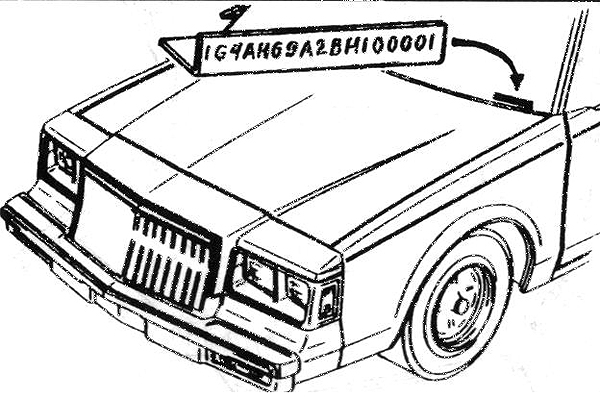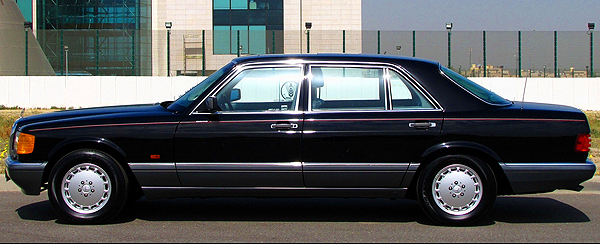
Vehicle identification plaques must be displayed under glass in such a way to be readable in daylight by a person with 20/20 vision. (Photo credit: The Turbo Regal Web Site)
Before 1981, vehicle manufacturers created their own vehicle identification (vin) numbers of varying lengths to signify facts about their vehicles as they saw fit. During the 1970s to ease confusion, the United States Department Of Transportation (DOT) mandated all vehicles built for sale in the U.S. by model year 1980 would have vin numbers conforming to a uniform set of guidelines.
(Note: due to departmental delays, the new vin numbering system did not actually go into effect until the 1981 model year).
Specific rules were set up about how vin numbers needed to be visible:
- Vin numbers for vehicles weighing under 10,001 pounds shall be clearly displayed on a plate located inside the vehicle, clearly readable in daylight by a person with 20/20 vision.
- Vin numbers of any two vehicles manufactured within a 30-year period shall not be identical.
- Type face used on vin number identification plaques shall be in san-serif font, with letters capitalized.
- To avoid confusion and misreading, alphabetic characters I, O, and Q shall not be used. All numerical characters 0-9 shall be used.
Specific rules regarding each of the 17 vin number characters were set up. For use as an example, a vin number from a 1991 Mercedes 420SEL (WDBCA35E7MA600000) is broken down…
CHARACTERS 1-3: (WDB)CA35E7MA600000. The first three characters represent a predetermined manufacturer code, agreed upon by the Society of Automotive Engineers. All vehicles manufactured by Daimler-Benz start with WDB.
CHARACTER 4: WDB (C) A35E7MA600000. This is a manufacturer-picked alphabetic character to signify the model “line” a vehicle belongs to. In this case, C signifies the Mercedes 126-body chassis all S-classes were produced on from 1980-91.
CHARACTER 5: WDBC(A)35E7MA600000. A manufacturer-picked code letter to signify the “series”. This is defined as a subdivision of a “line” denoting price, size or weight identification. On older vehicles, Mercedes typically used “A” to represent a gasoline engine subset.
CHARACTER 6: WDBCA(3)5E7MA600000. Manufactuer-picked code number to signify “body type”, which means the general configuration or shape of a vehicle distinguished by such characteristics as the number of doors or windows, cargo-carrying features and the roofline (e.g., sedan, fastback, hatchback). This car is a 420SEL model four-door sedan.
CHARACTER 7: WDBCA3(5)E7MA600000. Manfacturer-picked code number to signify “engine type”, defined as a power source with defined characteristics such as fuel utilized, number of cylinders, displacement, and net brake horsepower. In this case, “5” signifies the 420SEL’s 4.2-liter V8 engine rated at 201 net horsepower.
CHARACTER 8: WDBCA35(E)7MA600000. Until the late 1990s, this character was a manufacturer-picked code number or letter to signify further information about the vehicle. Mercedes chose “E” to signify this vehicle is equipped with seat belt and emergency pretensioners, and front airbags for driver and passenger.
After the late 1990s, the eighth character is mandated from a chart created by the United States Federal Department of Transportation to represent the vehicle’s “gross vehicle weight” rating class. (Gross vehicle weight refers to the maximum weight of the car plus cargo, passengers, fuel, etc).
CHARACTER 9: WDBCA35E(7)MA600000. A “check digit” authentication number arrived at by using a Department of Transportation formula which assigns numerical weight to all other sixteen vin# characters, multiplies those numbers together, then divides by 11. The numerical remainder from 1 through 10 is this check digit. If the remainder should be a 10, an “X” is used in place of a numeric character.
CHARACTER 10: WDBCA35E7(M)A600000. Determined by a D.O.T. chart, this number or letter represents the model year of the vehicle. Since this rating system was supposed to take effect for the 1980 model year, “A” was the starting letter for 1980, “B” for 1981, and so on. However, due to delays it did not actually begin until the 1981 model year – during which all ’81s were coded with a “B”.
Beginning with model year 2001, this character switched to a “1” for 2001, “2” for 2002…all the way through 2009. After that, “A” signifies 2010, “B” 2011, and so on. Since alpha characters I, O, and Q are not used, “M” refers to the 1991 model year.
CHARACTER 11: WDBCA35E7M(A)600000. A manufacturer-selected alphabetic character representing the specific factory a vehicle was assembled. “A” represents Mercedes-Benz’s choice for its largest assembly plant in Sindelfingen, Germany.
CHARACTERS 12-17: WDBCA35E7MA(600000). A chassis sequence number assigned by the manufacturer. For the 420SEL owner’s security, this part of the vin number has been changed. If the number here were accurate, “600000” would represent the six-hundred-thousandth 1991 model year chassis built on the Sindelfingen plant assembly line.
(Source: United States Department of Transportation Title 49, Part 565 – Vehicle identification number requirements.)


































